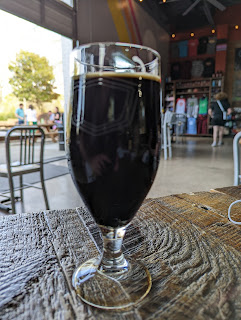"Portugal was the beginning, where I began to notice the things that were missing from the average American dining experience. The large groups of people who ate together. The family element."
- Anthony Boudain
I have never been to Portugal, although it is definitely on my culinary travel list. The country's relationship with food is a mixed story. On the one hand, Portugal had a key role in terms of the distribution of spices and other ingredients across the globe. At one point in history, the Portuguese had complete control over the African sea route, a long perilous journey around the Cape of Good Hope in southern Africa to lands such as Kerala (in India), Malacca (in Malaysia) and, ultimately to the Moluccas (in present day Indonesia). On the other hand, the Portuguese were a colonial power, which propagated the inhuman and immoral practice of slavery in the New World and oppressive violence in its colonies.
Yet, the good and bad are inextricably intertwined to form the one history of Portugal as a people. Just as they used to say that the sun never set on the British empire, the saying also applies to a certain extent to the Portuguese. The country had colonies that stretched from South America (Brazil) to Africa (Cape Verde, Guinea-Bissau, Sao Tome & Principe, Angola, and Mozambique to Asia (Goa, Macao). The Portuguese are well known for their role in bringing peppers from South America to Europe, Africa and Asia. And, I am a very big fan of that particular pepper -- the peri-peri or piri-piri.
So, I always thought that when I got to the personal culinary challenge to make a main course from Portugal, that it would feature that pepper. However, as it turns out, the challenge ended taking a completely different turn.
The (few) followers of this blog may remember that I have recently grappled with how to prepare a challenge for a country that has regional cuisines, like Spain and Canada. I have taken to using a random address and then building the challenge from there. I thought about doing the same for Portugal, which definitely has regional cuisines as one travels from Porto to Lisbon to Lagos, and then beyond to the Azores or Madeira. That is when I had what I thought was a great thought - as one goes down the coastline of Portugal, the one thing that all of those regions have in common is that very coastline. Seafood comes with coastline. With this thought, I had the building blocks for my culinary challenge.
APPETIZER
I don't know what it is about the Iberian peninsula, but both Spanish and Portuguese cuisines have recipes that combine octopus with potatoes. For an appetizer, I decided to explore the Portuguese version of this dish. While I have always loved the Spanish version, which is available at almost every tapas restaurant that I have eat at, I have to say that I loved the Portuguese version much more.
I have to admit that I departed slightly from this recipe. First, I did not pour the oil and the garlic from the roasted potatoes over the dish. I think this helped from making the octopus and potatoes seem "drowned" in oil. Second, while I like cilantro, I thought that parsley would work better. Finally, I left off the olives because of the guests who got to enjoy this dish. They were not olive fans.
POLVO A LAGAREIRO
Recipe adapted from Photos and Food
Serves 4
Ingredients:
- 2.65 pounds of octopus, either whole or tentacles
- 1 pound of fingerling or small white potatoes, with peel and washed
- 1 tablespoon kosher salt for boiling the potatoes
- 3/4 cup olive oil
- 1 1/2 teaspoon kosher salt for roasting the potatoes
- 4 cloves garlic, sliced thin
- 1 dried bay leave
- 1/4 cup cilantro (or flat leaf parsley)
- 1/2 cup black olives (optional)
Directions:
1. Boil the potatoes. Fill a medium to large pot half-way with water, add the 1 tablespoon of salt, and boil the potatoes for about 15 to 20 minutes or until they become tender. If using cooked octopus, skip to step 3, if using raw octopus, continue with the next step.
2. Prepare the octopus. Using your hands, wash the octopus under cold water, and boil the whole octopus for about 40 minutes or until tender (you should be able to insert a fork into the thickest part of the tentacle).
3. Prepare the oven and grill. Preheat both the oven for broiling and the BBQ or grill at 500 degrees Fahrenheit.
4. Continue to prepare the potatoes. Once the potatoes are ready, pour out the water and pat them dry with a paper towel. Place the potatoes in a roasting pan. Use the bottom of a glass or a mug to carefully press down on each potato until they slightly crack. Do not completely flatten them. Drizzle olive oil them. Place the roasting pan with the potatoes in the hot oven on the middle rack and roast for 5 to 10 minutes.
5. Grill the octopus. Place the octopus on the BBQ or grill for about 5 minutes, flip and then let cook for another 5 minutes.
6. Finish the dish. Scoop the potatoes onto a serving dish. Cut the octopus into bite sized pieces. Place the grilled octopus over the potatoes. Drizzle the olive oil and garlic from the roasting pan over the potatoes and octopus. Garnish with olives and cilantro (or parsley).
MAIN COURSE
As I mentioned above, I decided to build the personal culinary challenge around the one thing that may unit all of Portuguese cuisine in one way or another ... seafood. I decided to make a Caldeirada de Peixe, which is the Portuguese version of a fish stew that goes by many other names throughout the Mediterranean. To be sure, there are regional variations of this dish, which vary based upon the available fish and ingredients. The regional variations cannot obscure the fact that this dish represents Portugal, and, provides an ever so slight nod to the country's history from the shores to the seas.
CALDEIRADA DE PEIXE
Recipe from Photos and Food
Serves 4
Ingredients:
- 1 cup white wine
- 3 tablespoon tomato paste
- 1 teaspoon paprika
- 1/4 cup olive oil
- 6 pounds of fresh grouper cut into steaks (substitute conger or cod)
- 1 large cooking onion, sliced thin
- 5 cloves of garlic, sliced thin
- 1 tablespoon kosher salt
- 1 teaspoon cumin
- 1/2 teaspoon ground cinnamon
- 2 medium tomatoes sliced into thin wheels
- 1 large bell pepper sliced into thin wheels
- 2 bay leaves
- 8 sprigs of fresh flat leaf parsley with most stem cut off
Directions:
1. Build the stew. In a measuring cup with a spout, whisk together the wine, tomato paste, and paprika until well combined. Pour the olive oil into the bottom of a large dutch oven or heavy pot. Spread half of the sliced onions and garlic evenly over the oil and bottom of the pot. Place half of the fish steaks over the onions and garlic in one layer. Sprinkler 1/3 of the salt, cumin and cinnamon evenly over the fish.
2. Continue to build the stew. Place the tomato and pepper sliced wheels evenly over the fish. Spread the remaining half of the sliced onions and garlic evenly over the tomato and pepper slices. Place the remaining half of the fish steaks over the onions and garlic in one layer. Sprinkler 1/3 of the salt, cumin and cinnamon evenly over the fish.
3. Continue to build the stew. Place the remaining tomato and pepper sliced wheels evenly over the fish. Sprinkle the remaining salt, cumin and cinnamon over the tomatoes and peppers. Add the two bay leaves. Pour the wine mixture over the ingredients in the pot.
4. Cook the stew. Place the pot on the stove and turn the heat up to medium high. Once the liquid starts to bubble, cover the pot with the lid and reduce the heat to low. Let simmer for about 30 minutes or until the fish starts to flake. Turn off the heat, uncover the pot, and add the springs of fresh parsley over the cooked ingredients. Serve with steamed/boiled potatoes, rice or a green salad.
* * *
Needless to say, I think I can chalk up another successful personal culinary challenge. The guests who got to enjoy both dishes certainly thought that I did a good job. It was just the morale boost that I needed as I contemplate some much more difficult challenges ahead. Until next time,
ENJOY!










